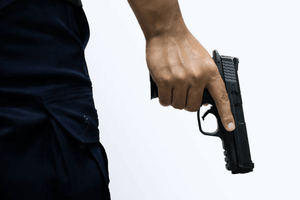When it comes to guns, safety always comes first. You’ve probably heard this countless times, and yet some people still wonder why it’s so important.
Gun safety concerns all the gun community, whether you're a beginner, expert, enthusiast, or collector. It protects the people around you, and it also protects you.
If you’re new to shooting, establishing a strong foundation in safety is essential. For seasoned shooters and enthusiasts, sharing these safety rules with others—whether it's a neighbor, family member, or friend—can make a significant impact.
You just can’t take gun safety for granted. Even experienced shooters can fall into the habit of making small mistakes without realizing it, like unintentionally crossing the gun’s muzzle with their hands or neglecting to check their red dot sights. These micro infractions can lead to dangerous situations, which is why continuous attention to safety is so important.
So, even though this gun safety guide is titled for beginners, it also offers valuable tips for expert shooters and all the gun community. Be sure to keep reading as we cover the four basic gun safety rules, safe firearm handling, Gun storage tips and shooting range rules.
Basic Gun Safety Rules
The NRA's fundamental rules are widely recognized as the gold standard for gun safety. These rules are designed to prevent accidents and ensure that everyone handling a firearm does so responsibly.
Let’s take a look at the 4 basic rules of gun safety, which apply to shooters of all levels, from beginners to experts:
Treat Every Gun as if It's Loaded
The first rule of gun safety is to always assume a firearm is loaded, even if you believe it’s not. This mindset helps prevent the unfortunate “I didn’t think it was loaded” accidents. No matter how certain you are that a gun is empty, you always need to keep this rule in mind.
You should always know the condition of your gun. This is why you often see shooters regularly checking if their handgun’s chamber is loaded and if there’s a magazine in the gun.
How can you be sure about your gun’s condition? Let’s go over a simple clearing procedure for your handgun:
- Point the firearm in a safe direction, ensuring no one could be harmed.
- Remove the magazine by clicking the magazine release and taking out all ammunition.
- Pull back the slide twice as a double-check to ensure that no rounds are left in the chamber.
- Observe the chamber. With the slide locked to the rear and the gun pointed downrange, visually inspect the inside of the barrel and the magazine well. This redundancy in your safety check ensures that the firearm is indeed clear.
Even after this clearing procedure, you still need to handle the gun as if it were loaded. This is to reinforce the first rule of gun safety: you minimize the risk of accidental discharge and ensure a safer environment for everyone around you.
Keep the Muzzle Pointed in a Safe Direction
The second basic rule of gun safety is to always keep the muzzle pointed in a safe direction. But which direction is safe?
In practical terms, for instance, shooting range rules indicate that you should always keep the barrel pointed downrange. This area is specifically designed to safely absorb and contain all discharged rounds. It’s the safest direction at a shooting range because it is equipped to handle live fire.
It’s critical that the muzzle of your gun must never break the 180-degree plane. This way, you ensure that it never points toward anything or anyone you don't intend to shoot.
You should never point a gun at anyone unless you are in a serious self-defense situation. Similarly, you must avoid pointing the muzzle toward any part of your body. For example, never check if your red dot sight is working by pointing the gun at your own hand. These habits, though seemingly minor, are vital to maintaining safety.
Keep Your Finger Off the Trigger Until Ready to Shoot
The third essential rule of gun safety is all about trigger discipline. You should never place your finger on the trigger unless you’re pointing your gun, with sights aligned, and you genuinely intend to shoot. Adhering to this gun safety rule helps prevent accidental discharges.
So, what’s the safe way to handle a gun’s trigger? Just as we covered in our marksmanship guide: with a solid grip, you should rest your trigger finger along the frame of the gun until you’re actually aiming at your target. By keeping your finger outside the trigger guard and away from the trigger, you maintain control over when and where the gun fires.
Want to get to practice and get to know your gun’s trigger better? Then dry firing with an unloaded gun is the best option.
Be Sure of Your Target and What's Beyond It
The fourth basic rule of gun safety is about identifying your target clearly and ensuring a safe backstop. This important rule has two parts: knowing exactly what your target is and being aware of what lies beyond it.
Let’s explain this gun safety rule more in detail:
First, you need to be completely sure about your target. Seems like an easy rule? Well, unfortunately, every year we hear stories about hunters who accidentally shot someone because they saw movement in the bushes and assumed it was an animal.
So, to be clear: You always need to positively identify your target, whether it’s a deer in the woods or a potential threat in a self-defense situation.
But the fourth rule of gun safety goes beyond positive target identification. You also need to be aware of what’s behind your target, as a round may pass through it. Actually, you should be conscious of what’s next to your target in every direction—left, right, up, and down.
By adhering to this gun safety rule, you prevent unintended harm to anyone or anything near the target.
Safe Firearm Handling

We’ve covered the four basic gun safety rules for beginners and experts, which is great. But perhaps you have other safety questions and concerns, like how do you safely store a gun, or how do you safely store ammo? What’s the best way to carry a gun?
These are some of the questions we’ll answer right here as we expand on additional safety practices for handling firearms.
Loading and Unloading Safely
Loading a gun safely starts with ensuring that your handgun is unloaded. To do this, you just need to follow the same clearing procedure we explained in the first rule of gun safety—Treat Every Gun as if It’s Loaded:
Point your gun in a safe direction and rack the slide back. If there is a round in the chamber, this will eject it.
Once you’ve done this, you’ve successfully unloaded the gun.
To load your gun, start by inserting the magazine into the well until it clicks. At this point, the gun is loaded in terms of the magazine being inside the firearm, but there’s no round in the chamber yet.
After this, and only when you intend to shoot, should you load the gun’s chamber. Rack the slide once, and your gun will be ready to fire as soon as you pull the trigger.
A few important safety considerations when loading and unloading your handgun:
- Simply dropping the magazine does not unload the firearm.
- Just because a firearm failed to fire doesn’t mean it is unloaded.
- Never rely solely on the gun’s built-in safety switch.
Storing Firearms Securely
Responsible gun ownership means storing your firearms in a safe place where they are not accessible to unauthorized persons. It’s especially important to ensure that handguns are kept out of reach of children and home visitors.
Gun safes are a popular choice for storage, as they come in various sizes, from small portable cases to large cabinets designed to store multiple firearms. Safes also feature different locking systems, including keys, fingerprints, passcodes, and more.
You just need to be sure that you can quickly unlock your gun safe when needed. This is why, especially in high-stress home defense situations, many consider biometric safes superior to key locks or combination locks.
Do you own multiple guns? In that case, consider using trigger locks and cable locks as extra layers of safety when storing them.
Also, take into account that different states have different secure gun storage laws.
Keeping Ammunition Separate
By storing your ammunition away from your firearms, you prevent unauthorized access to both. When you buy a box of ammo, don’t just store it on a shelf or in the attic. Just know that proper storage can in fact save your ammo.
To store your ammunition you can consider using a waterproof ammo can or even a sealed Tupperware container. Anything that seals tightly will do the job. Simply place the factory box inside, and it will keep your ammo fresh and protected from moisture. You can include a silica gel packet in the storage box for added protection.
Also, you want to store your ammo in a cool place so they are not exposed to extreme temperatures, especially heat. The powder and primer compound in ammunition degrade over time, and heat accelerates this process, potentially compromising your ammo’s effectiveness.
Safe Carrying Practices
Carrying a firearm safely is just as important as storing it securely. A key aspect of safe gun carry is choosing the right holster. They have to be comfortable, offer full trigger guard coverage and secure retention.
That’s what you get with our exclusive 45 Blast Yedi Ventcore Holsters. We craft these with security and comfort in mind. Be sure to check all the outside and inside the waistband options we have available.
Shooting Range Etiquette
Finally, let’s talk about gun safety in one of the gun community’s favorite places: the shooting range. Range safety rules may vary depending on the state and facilities, but here are some common rules that help maintain a safe environment for everyone:
- Always follow the Range Master’s instructions: They are responsible for the safety of everyone at the range, so it's crucial to do what they tell you.
- Don’t break the 180-degree rule: The muzzle of your firearm should never break the imaginary 180-degree line from the established firing line. Keep the muzzle pointed completely up, down, or downrange.
- Establish and share your zone of fire: Make sure everyone knows their zone of fire and is aware of each other’s positions at all times. This helps prevent accidental crossfire.
- Never handle firearms behind the safety line: Always uncase and case your gun at the shooting bench to ensure safety.
- Uncase only one firearm at a time: If you bring more than one firearm to the range, it’s recommended to uncase and handle only one at a time.
- Wear eye and ear protection: These are usually mandatory at shooting ranges. They protect you from potential hazards, so always wear them.
- Alert a Range Safety Officer to any unsafe situation.
- Holster or case all firearms when entering or exiting the shooting range.
And remember, adhering to range safety rules also makes a fun environment.
Conclusion
In summary, gun safety is essential for everyone, from beginners to experienced shooters. The four basic NRA rules form the foundation of responsible firearm handling and ownership.
In addition to these rules, we also have to consider proper storage, safe carrying, and shooting range etiquette. It’s more than just following the rules—it’s about creating a culture of responsibility and respect within the gun community.
We hope you join our 45 Blast team at the range, always safe, always sharp. Let’s continue to practice and enjoy our sport, knowing that we’re doing so in the safest way possible.


